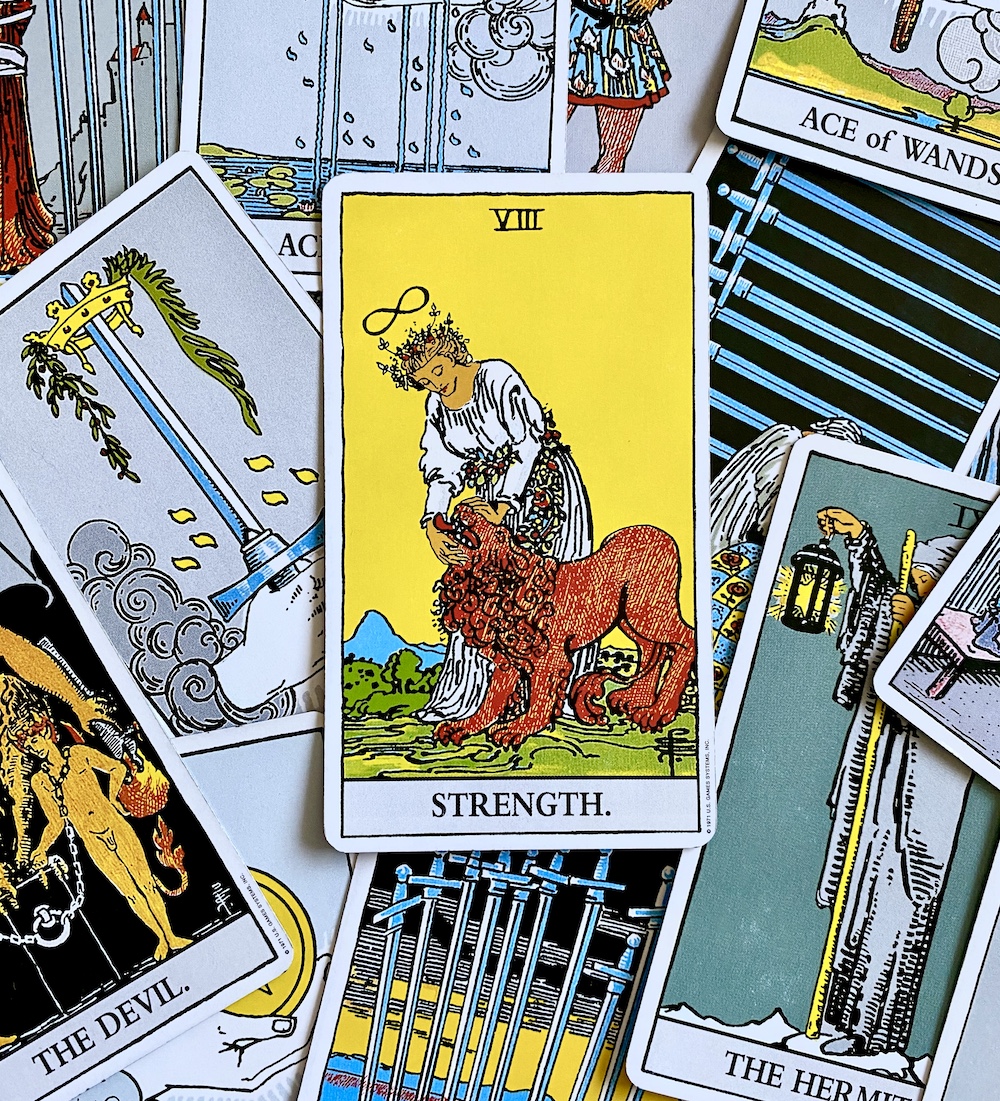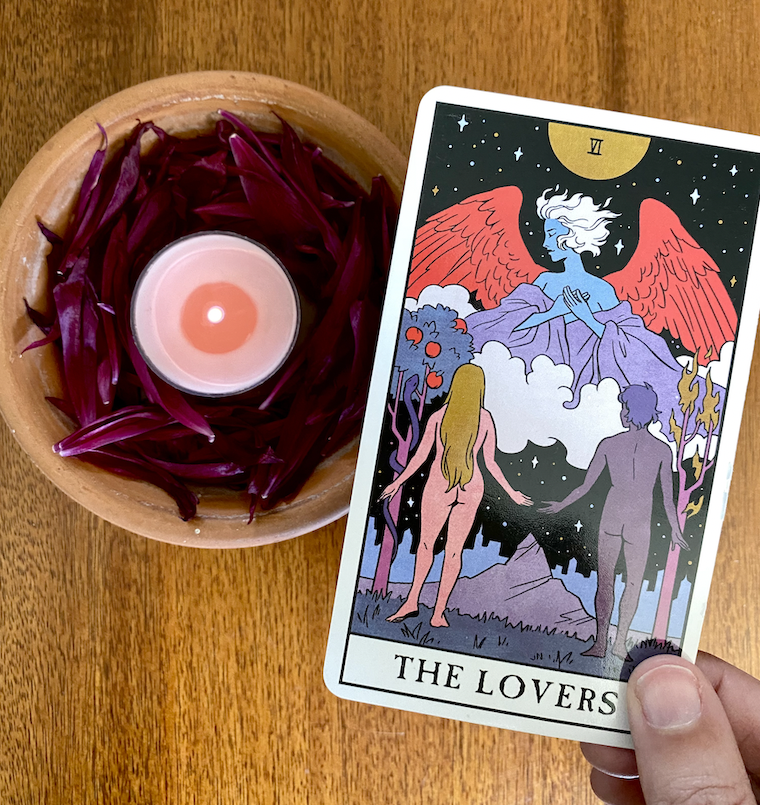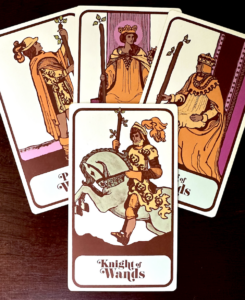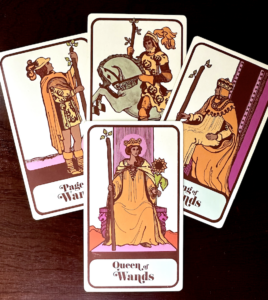
[This post may contain affiliate links. This means that I may earn a small commission at no extra cost to you if you follow one of my links and end up making a purchase.]
If you’re a beginner, the best way to learn to read tarot for yourself is to start a daily tarot practice.
And if you’re more advanced, a daily tarot practice keeps you connected to your cards and your intuition.
Here’s how to start your own daily tarot ritual from scratch – even if you have never worked with tarot cards before!
Why is a daily tarot practice a good idea?
Learning to read tarot for yourself can be so powerful. It’s not just a fun witchy party trick (although it certainly can be if that’s all you want from it).
In fact, my life changed in so many wonderful ways – both big and small – when I started working with tarot regularly. To name just a few:
- It has helped me distinguish between my ego and my true, authentic self
- Tarot is a wonderful way to practice connecting with your intuition
- Reading tarot helps me make more aligned decisions
- I am better at recognizing and processing my emotions now!
- Tarot gives me a deeper understanding of spirtuality, psychology, and more.
And the best way to learn to read tarot – including learning all those tarot card meanings – is to just dive right in! A little bit each day goes a long way. So here is a step-by-step guide to developing your own daily tarot reading practice.
1. Choose a tarot deck that’s right for you.

You can start reading tarot cards with any tarot deck that resonates with you. The most important thing is that you like working with after all. But there are many tarot decks out there, and not all tarot decks are created equal – especially if you are a beginner who is serious about learning tarot card meanings and how the system of tarot works.
Is that you? Then I recommend starting with the Rider Waite Smith deck, or a close derivative of that deck. Why? Because the RWS deck is the most popular deck and traditional tarot card meanings are based on the imagery of that deck! In other words, it is the answer key deck that is the easiest to learn with.
[Related: Why You First Tarot Deck Matters]
2. Set aside a consistent time each day for your tarot practice.
Consistency and routien are always our friend any time we are trying to develop a habit! So pick a time of day that you can routinely set aside for your daly tarot practice. It doesn’st have to be very long. Ten minutes each morning is a perfect amount of time and what I prefer. Alternatively, a 10-20 minute evening routien or bedtime ritual might work better with your schedule.
Common wisdom says that “the veil is thinnest” right after we wake up and right befofe we fall asleep, so you might take that into consideration. What the heck am I talking about!? When the brain is awake but not fully alert and caffeinated or stimulated, it is more likely to be in lower beta wave or alpha wave mode, which is a relaxed frame of mind that is more conducive to accessing your intuition.
3. Create a peaceful environment that will allow you to relax and focus.
I sometiems hear about people pulling a tarot card real quick before they rush out the door to get to work on time, or having a deck in their purse so they can pull a card in traffic real quick to see how their day is going to go. And while I am not here to knock anybody’s practices or beliefs, if you are reading this, you want my recommendation for developing an effective daily tarot practice, right? So I’m going to say not that.
And here’s why.
Working with tarot cards and reading tarot for yourself is about slowing down, tuning in to your inner wisdom, and really connecting to your authentic self. It’s not about getting an answer real quick or passing the time or anything like that. So much so, in fact, that if I am distracted or rushed, I will skip my tarot reading because there’s no point. The practice isn’t even realy about the card you pull – it’s about the process of centering, tuning in, and accessing your intuitive wisdom, which is a beautiful and essential way of knowing and navigating the world that most of us simply have no practice with.
You don’t have to buy all the crystals and sit in darkness ave for the light of a singel white votive or anything like that. Just find a corner of your home where you can sit comfortably and quietly for a few minutes without distraction or interruption.
That’s it.
4. Take a few deep breaths to center before pulling cards.
Over the years I have discovered that this is a deceptively essential step. To echo what I said in the previous step, a personal tarot practice isn’t even really about what cards come up for you each day. It is about the process of pausing, slowing down, and tuning in to our inner wisdom.
And for me, that means closing my eyes and taking a few slow, deep breaths. I think of the first inhale-exhale as the pause. The second inhale-exhale is to relax. And the third one is to tune in to my breath, which invites my ego to take a back seat and allows my intuition to open.
Some people like to do a meditation or something before they read. If you have the time and the familiarity with a meditation rpactice, like a body scan or a grounding meditation perhaps, go for it. If not, just a few moments to breathe will do wonders!
5. Shuffle your tarot cards and ask your daily tarot question.
As I said before, your daily tarot practice need not be overly complex or lenghty. Ten minutes a day to pull a card or two is a fantastic way to start learning to read without getting overwhelmed. This kind of daily draw helped me learn tarot naturally and easily. It also helped me connect to the cards and learn their meanings intutively without having to emrmozie. It also allowed me to set a daily intention to help me show up as my best self each day – applying the wisdom of tarot right away!
The best daily tarot questions for giving yourself a tarot reading are open-ended questions that focus on agency and empowerment. For example, instead of “What’s going to happen today?” which is not empowering, you might ask, “How can I show up as my best self today?”
You can get more specific depending on your energy or intention. For example, one I ask often is “How can I open my heart today?” or “How can I view the world thorugh the eyes of love today?” because sometimes I’m an anxious, low-key rageaholic who JUST. CAN’T. EVEN. Just saying! Tarot can help you with anything!
In conclusion, the best way to develop a daily tarot practice – and to learn the meanings of cards without robotic memorization – is to pull a daily tarot card. That’s it. Pull one card each day and interpret that one card and see how you can apply its message to your life in this moment.
[Related: Daily Tarot Spread for Positivity]
6. Reflect in a tarot journal.
The way we get better at tarot reading, by the way, is to reflect on the cards we draw and attempt to interpret them ourselves based on the imagery – before looking up the card’s meaning in a tarot guidebook or on a tarot meaning website.
I’m going to repeat that again because it is a game-changer.
Put down the guidebook!

Look at the card you just pulled and describe what you see. (This, again, is why the Rider Waite Smith tarot deck isa godsend when learning tarot meanings. You just describe what you see. This does NOT apply to all tarot decks, some of which depict super abstract, random, and irrelevant images that make learning traditional tarot meanings difficult if not near impossible.)
How does the card make you feel? What do you notice in the imagery? What does it remind you of? How does it relate to the question you asked?
Record all your insights in a tarot journal.
Then, after you have already taken a stab at interpreting the card yourself, you can look it up in a trusted guidebook or web source. Not only will you likely be pleasantly surprised at how close you come to the traditional definition for many of the cards, but this act of studying is how you will naturally remember the meanings without rote memorization.
Tarot journaling is fantastic for a few other reasons as well:
- You can follow up on your readings to see how you did with your interpretations and to add insights that come to you later.
- The act of writing out our interpretations and reactions to cards helps us become fluent in tarot reading
- We can easily spot patterns or repeated messages (you will start to notice that a few tarot cards will keep coming up for you over and over again!)
7. Rinse and repeat!
That’s it, my friends. Repeat this tarot practice daily and watch as both your intuition and your understanding of the tarot cards develop over time.
















1 Comment
[…] [Related: How to Start a Daily Tarot Practice – from Scratch!] […]